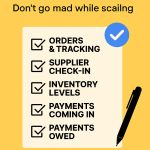
The Indian Dropshipper Cash Flow Survival Guide (2025 Edition)
Indian Dropshipper Cash Flow Survival Guide
Table Of Content
- 💸 Why Cash Flow is Everything in Indian Dropshipping
- ✅ Step 1: Track Every Rupee (Not Just Orders)
- ✅ Step 2: COD Reconciliation = Daily Ritual
- Step 3: Maintain a 7-Day Buffer (No Matter What)
- ✅ Step 4: Don’t Scale Until Your Systems Are Clean
- ✅ Step 5: Build Payment Discipline with Suppliers
- ✅ Step 6: RTOs Are Not Refunds, They’re Cash Flow Grenades
- Final Word: Scale Without Stress
If you’re running COD-heavy Indian dropshipping and your cash keeps vanishing, this Indian Dropshipper Cash Flow Survival Guide will save your margins, sanity, and growth plan.
Let’s be real — ads are fun, creatives are sexy, but if your bank balance is a rollercoaster, you’re not building a business. You’re surviving.
This isn’t a finance lecture. This is the Indian Dropshipper Cash Flow Survival Guide — a raw, no-fluff playbook for making sure you don’t run out of cash before the next payout hits.
If you’re doing COD, juggling suppliers, prepaying for ads, and praying your courier settles on time — this one’s for you.
💸 Why Cash Flow is Everything in Indian Dropshipping
Running a profitable store means nothing if your money’s stuck in limbo.
You paid:
- ✅ ₹10K for ads on Day 1
- ✅ ₹8K to supplier on Day 2
- ✅ ₹5K on packing + team help
But your cash from COD orders? Won’t show up till Day 12–15 (if you’re lucky).
This delay is the killer. That’s why you need this Indian Dropshipper Cash Flow Survival Guide — to keep moving without getting squeezed.
And let’s not forget — every day of delay stacks. One order missed? You manage. But stack 20 orders over 3 days and suddenly you’re ₹50K in the red with no liquidity. That’s not just stressful — that’s fatal.
Add to that: Facebook ad bans, GST filings, or a delayed supplier shipment — and boom, you’re stuck. It’s not about being perfect, it’s about being prepared.
✅ Step 1: Track Every Rupee (Not Just Orders)
Forget dashboards. You need a spreadsheet — expenses in, income out. Track:
- Ad spend (daily)
- Supplier cost per SKU
- Packing + courier charges
- Refunds issued
- COD collected vs pending
This is where most fail — they look at Shopify revenue and forget actual cash in hand. Don’t be that guy.
Use Google Sheets, Notion, even pen and paper if needed. Make it stupid simple — but brutally honest. No guessing. No “I think.” Track daily. Review weekly. Adjust monthly.
Want to be pro? Color code. Red = pending. Green = received. You’ll spot leaks before they drown you.
✅ Step 2: COD Reconciliation = Daily Ritual
Every evening, you:
- Check what was delivered
- Check what was paid
- Flag any delays or pending payouts
If your COD isn’t tracked daily, it’ll choke you in 10 days flat. Most courier partners show settled amounts inside their dashboard. Monitor them like your ex watches your Instagram.
And trust me — they make mistakes too. One missed delivery update and you’re chasing ₹2,000 for weeks. This ritual helps you catch gaps fast.
Even better? Automate it. Use tools like GoKwik, Razorpay Recon tools, or even webhook-based trackers. But even if you’re doing ₹1K/day — build this habit from day one.
Step 3: Maintain a 7-Day Buffer (No Matter What)
Always keep enough cash to:
- Run ads for 7 days
- Place new orders for your bestsellers
- Cover courier & refund cycles
If your buffer drops below that, pause scaling. Go into profit lock mode. This one rule from the Indian Dropshipper Cash Flow Survival Guide will save your brand from death-by-RTO.
I call it the Rainy Week Rule. Business or not — life happens. Laptop crashes, someone falls sick, ad performance tanks — if you don’t have that 7-day financial cushion, your business can die from one bad Monday.
Make this a non-negotiable. Like your rent.
✅ Step 4: Don’t Scale Until Your Systems Are Clean
Want to go from ₹5K/day to ₹25K/day? Cool. But can your cash flow take the hit?
More orders mean:
- More upfront cost
- More returns
- More customer support
Your ops, payouts, and reorder system needs to be solid before you scale. Otherwise you’ll drown in orders you can’t fulfill.
Scaling without clean ops is like jumping into the ocean without checking if you can swim. You might go viral, but you’ll go broke faster.
Document SOPs. Assign team roles. Have backups. If you want to scale, your backend should already feel scaled.
✅ Step 5: Build Payment Discipline with Suppliers
here’s your original message extended to around 300 words, keeping your no-nonsense, clear, slightly conversational tone intact:
Add fixed payment dates. Not “somewhere next week” or “once the client pays” — fixed be predictable That’s the first rule of managing cash flow. If your vendors know when they’re getting paid, you’ll always be in their good books — and that’s worth more than discounts sometimes.
Don’t prepay unless it’s *really* urgent. Keep your cash where you can see it. Your business needs flexibility, not panic payments just to feel “on top” of things. Liquidity is leverage.
Set terms. Stick to them. Negotiate 50-50 deals or break it into weekly payment cycles. Keep it tight and simple. No overcomplicating. Just structure that everyone can rely on. Once that’s set, don’t break it for every little delay or emotion. This is business — not mood-based spending.
If you keep buying like a panic buyer on sale day, your cash flow will always suck. Straight up. It’s tempting to stockpile when you see a “deal” or fear a shortage, but that kind of behaviour burns you in the long run. Be boring. Be consistent. Predictable is powerful — that’s how you actually scale.
Suppliers respect consistency way more than excitement. Be the one who always pays on time, not the one who sends heart emojis but pays 10 days late. Pay early if someone’s a star performer — that’s your loyalty bonus. But the flaky ones? Cut order size, tighten timelines, and let your terms remind them that you’re serious.
And yes — treat payments like payroll. Late = strained relationships = delayed stock = lost sales. That’s the chain. Don’t break it. Build clean cycles, and you’ll sleep better and grow faster.
This isn’t just about paying bills. It’s about running a business like a pro.
✅ Step 6: RTOs Are Not Refunds, They’re Cash Flow Grenades
Every failed delivery means your cash is locked for 10–15 days. Factor that in.
Your courier might show a return, but that cash? Still 2 weeks away.
Keep a separate line item in your cash flow sheet:
- Products in RTO
- Value locked
- Expected return timeline
This will stop surprise zero-balance moments mid-month.
Also — track repeat offenders. If certain pincodes always RTO, block them. If a product type leads to more returns, fix the offer or stop selling it.
RTO isn’t just a cost. It’s a signal. Use it. Learn from it.
Final Word: Scale Without Stress
The Indian Dropshipper Cash Flow Survival Guide isn’t just about staying alive — it’s about building something real.
If your cash flow is sorted, you move faster, launch quicker, recover better, and actually enjoy the game.
And yeah, nobody posts cash flow wins on Instagram. But in the real world? That’s what keeps your business alive.
Run your store like a business. Not a weekend gamble.
More guides like this dropping soon on dropshipping.blog. Bookmark it. Stay prepared. Play smart. Grow real.




